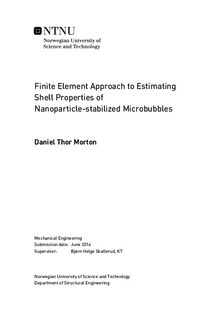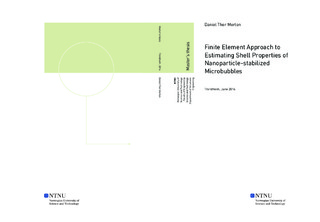| dc.description.abstract | The application of nanoparticle-stabilized microbubbles (NP-MBs) for localized drug delivery is a new and promising method for enhancing the effectiveness of administered drugs. The NP-MBs move through the vascular system before being destroyed by a targeted acoustic pressure field. The NP-MBs shell properties determine the in-vivo response. Accurately determining the shell properties will allow us to better understand the complex phenomenons which make this method an valuable medical tool. This thesis aims to utilize finite element modeling in order to better estimate the NP-MBs shell properties.
Previous thesis work at the Department of Physics has conducted a series of experiments where individual NP-MBs were compressed by an atomic force microscope. The bubbles force-displacement curve is the basis for estimating the shell properties. This system is considered equivalent to a parallel plate compression of a hollow sphere. A finite element model representing a NP-MB model was simulated in Abaqus. Running different parameters and material models the, Yeoh material model was identified as a better alternative to the traditional linear elastic material. The linear elastic model resulted in a poor fit to the experimental data, with the bubbles different Young's modulus ranging from 25MPa to 112.5 MPa. By using Yeoh form the non-linear response of the NP-MBs were better replicated. The Yeoh form, typically used for rubber materials, allow a non-linear stress-strain relation. The different bubbles were simulated with the Yeoh material and the estimates for the most relevant coefficient, C_{20}, ranges between 0.96e6 and 112.5e6
An alternative method for estimating the shell thickness is suggested. The simulations buckling point is dependent on the dimensions and parameters of the input. By matching the buckling point of the experiments force-displacement with to the buckling point of a simulated model we are able to suggest and estimate for the shell thickness. The method indicates a negative relation between the shell thickness MB diameter. The shell thickness of the different BSA microbubbles was between 0.05 and 0.065 micrometer. The different casein bubbles have an even thinner shell with estimated thicknesses ranging from 0.05 micrometer to below the lower limit (0.25 micrometer) of the suggested method. | |

